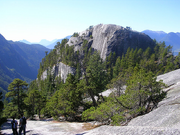
Granite /ˈɡrænɨt/ is a common type of intrusive, felsic, igneous rock which is granular and phaneritic in texture. This rock consists mainly of quartz, mica, and feldspar. Occasionally some individual crystals (phenocrysts) are larger than the groundmass, in which case the texture is known as porphyritic. A granitic rock with a porphyritic texture is sometimes known as a porphyry. Granites can be pink to gray in color, depending on their chemistry and mineralogy. By definition, granite is an igneous rock with at least 20% quartz by volume. Granite differs from granodiorite in that at least 35% of the feldspar in granite is alkali feldspar as opposed to plagioclase; it is the alkali feldspar that gives many granites a distinctive pink color. Outcrops of granite tend to form tors and rounded massifs. Granites sometimes occur in circular depressions surrounded by a range of hills, formed by the metamorphic aureole or hornfels. Granite is usually found in the continental plates of the Earth's crust.
Granite is nearly always massive (lacking internal structures), hard and tough, and therefore it has gained widespread use as a construction stone. The average density of granite is between 2.65 and 2.75 g/cm3, its compressive strength usually lies above 200 MPa, and its viscosity near STP is 3-6 • 1019 Pa·s. Melting temperature is 1215 - 1260 °C.
The word "granite" comes from the Latin granum, a grain, in reference to the coarse-grained structure of such a crystalline rock.
Granitoid is a general, descriptive field term for light-colored, coarse-grained igneous rocks. Petrographic examination is required for identification of specific types of granitoids.